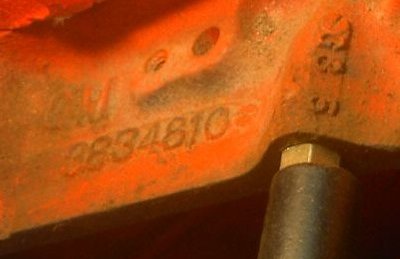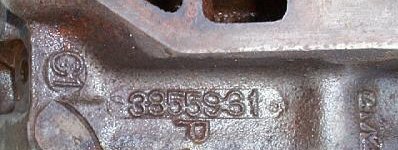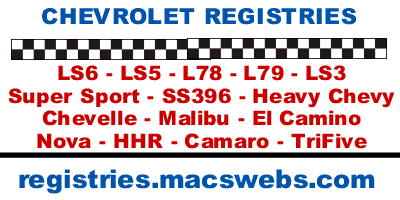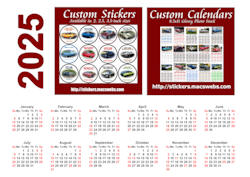Engine Section Links
ENGINE ID CODES
Engine Stampings
Air Cleaner Part Numbers
Air Cleaner (Pos Vent)
Air Cleaner (K24)
Air Conditioning *
A.I.R. (Air Injection Reactor)
Belt Part Numbers
Belt Routing
Block
CAMSHAFT
CASTING NUMBERS (BLOCK & HEADS)
Chrome Accessories
Cooling System
Cylinder Head
Exhaust
FUEL SYSTEM *
GENERATOR
Ignition
Miscellaneous
Mounts, Engine
Oil Pan
PCV Valves
Power Teams
Pulleys
Starter
Steering
* These sections have multiple pages and those pages only have links to that section and one link to return here.
V8 Block & Head Casting Numbers
The block casting number on small block and big block Chevrolet V8 motors is located on a ledge found at the rear of the block, most often on the driver's side. This ledge is below the deck of the block and the ledge forms the mating surface between the block and the transmission bell housing.
No current information about 6-cyl castings are available.
| Casting Number | Engine Size | Engine Horsepower | Main Caps/Information |
| 3834810 | 283 | 195 - 220 | 2-bolt main bearing caps only used by Tonawanda engine plant. |
| 3849852 | 283 | 195 - 220 |
2-bolt main bearing caps. When used with nodular iron crankshaft the block was relieved at the bottom of the cylinders for counterweight clearance. When used with a forged steel crank there are no reliefs. |
| 3857656 | 327 | 275 - 350* | * March 1966 introduction |
| 3858180 | 327 | 275 - 350* | * March 1966 introduction |
| 3855961 | 396 | 325 - 360 | 2-bolt main bearing caps |
| 3855962 | 396 | 360** - 375 |
4-bolt main bearing caps high performance casting. Some, if not all, 360hp engines used this block even though it was not call for that application by Chevrolet. |

Block casting 3834810 ~ 283 195/220hp. Also note casting date
G35 for July 3, 1965. This block was only used by Tonawanda
and this block was also used in 1964 and 1965 applications.

Block casting 3855961 ~ 396 2-bolt (325/360hp) main caps.

Block casting 3855962 ~ 396 4-bolt (375hp) main caps. Reportedly used
in 360hp applications as well. Due to scheduling and parts being available,
4-bolt blocks were sometimes substituted for 2-bolt applications but
never the other way around. Many times during a production run a 2-bolt
block was drilled for a 4-bolt application with no documentation to
verify the change. The 3855962 block is a good example of this. It is
believed the letter "P" indicates the block was destined for passenger
car and not a truck, but no documentation has surfaced to confirm/deny
this.
** It has been verified that this block was installed in some 1966 Chevelle 396/360hp engines. This caused some problems for Chevrolet Service. See Engine Parts > Block for more information on this block.
Engine Assembly Date/Suffix Code:
The engine assembly code looks similar to T0422ED.
In this case the first letter "T" stands for an engine
factory Tonawanda, an "F" or "V" for
Flint or "K" for McKinnon Industries. The next two
digits indicate the month of the year, in this example "04"
for the fourth month, April. The "22" indicates the
22nd day of the month. So what do we have so far in this example? The
motor was assembled at the Tonawanda factory on April 22. The calendar
year itself is not given but remember that the engine assembly had to
be manufactured and assembled before the car was built. What we have
left is the "suffix code" which in this example is ED,
a 1966 396cid with 325hp and coupled to a manual transmission. Chevrolet
used two letters to code the type, size, and horsepower rating of the
engine and the transmission type to be used with that engine.
The final vehicle assembly plant sometimes stamped a VIN derivative on the same machined area as the engine ID code. This stamping wasn't mandated until the 1968 model year but has been found (and not found) on 1966 models. If yours has the VIN derivative (and hasn't obviously been restamped), you can be sure the engine is original to your Chevelle. The VIN derivative might look like "T0422ED 6A123456" stamped into the pad on the front passenger side of the block. In this example, 6A123456 decodes to 1966 model year, Atlanta final assembly, and the sequence number of the VIN. Sometimes the VIN derivative was stamped into a different area of the block on the flange edge of the rear of the block, near the bell housing mating surface. Sometimes the stamping is found above the timing cover mating surface on the front of the block.
While NOT a hard and fast rule, it has been found that mainly the higher horsepower engines such as the 327/350 RPO L79 and all SS 396 engines have a VIN derivative stamping. Mandatory VIN stamping of all engines was not required by federal law until the 1968 model year.
V8 Cylinder Head Casting Numbers
| Casting Number | Engine Size | Engine Horsepower | valve Size (intake/exhaust) - combustion chamber volume |
| 3884520 | 283 | 195 | 1.72/1.50 - 60.530 c.c. Pyramid casting symbol |
| 3782461 | 327 | 275 350 (late March) |
1.94/1.50 2.02/1.60 Double-hump casting symbol produced to about June, 1966. |
| 3890462 | 327 | 275 350 |
1.94/1.50 - 62.076 c.c. 2.02/1.60 - 62.076 c.c. Used after January, 1966. |
| 3872702 | 396 | 325 - 360 | 2.06/1.72 - 98.427 c.c. Oval port, spark plug shield boss, no temp sending boss. |
| 3873858 | 396 | 375 | 2.19/1.72 - 108.989 c.c. Square/rectangle port |




